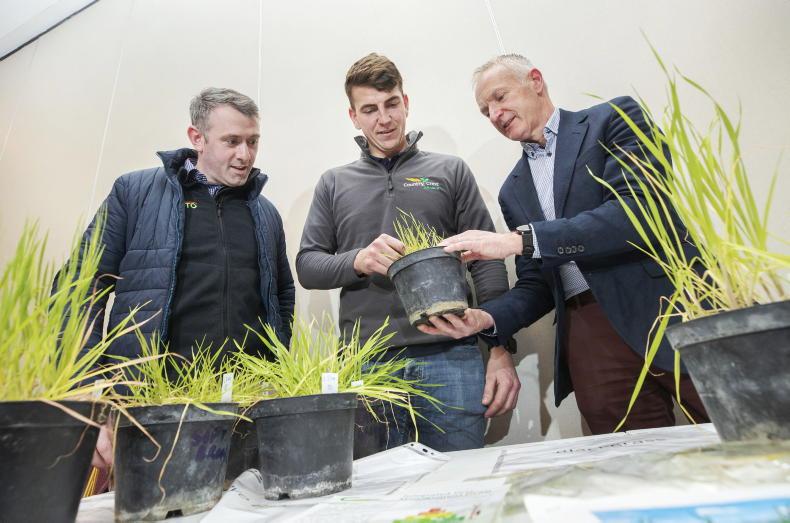Teagasc’s John Mahon explained that if you find blackgrass, or slender foxtail to give it its official title, on your farm you must intervene without delay.
Farmers should be walking fields regularly for blackgrass and need to be informed on what this weed looks like, as well as other grass weeds. He urged farmers to seek advice from an agronomist or attend a workshop or event to learn about these plants and see examples of them.
It is important to have a hand lens or magnifying glass to identify some of the characteristics. It can also be useful to bring a weed guide with you or have an app on your phone.
Key things to look out for when identifying blackgrass
Purple at the base.Early leaf blade twist is clockwise.Blackgrass does not have any hairs on the leaf or the stem.Jagged ligule (membrane flap behind the stem, where the leaf meets the stem).No auricles around the stem, where the leaf reaches the stem.Slender, long plant.Seed anthers (flowering parts in May).Green in May, turns purple/black in June (going to seed shed at this time, needs to be controlled).What to do if you find blackgrass in your field
Put a plastic bag over the plant. Don’t allow it to shed as you pull it.If there is too much to rogue, spray it with glyphosate.It is possible to make wholecrop silage when the blackgrass is still green before changing colour and going to seed.Don’t allow slurry from animals that consume it back on to tillage land.Clean machinery before leaving a contaminated field.What to do with that field?
Plough if in a minimum-tillage situation.Rotational ploughing (one year in five) can bury the seed until it becomes unviable.Use shallow cultivation to create a stale seedbed.Delay drilling in autumn from peak germination period.Increase seed rate for better crop competition.Stopping the gaps
John emphasised the importance of certified seed and that the Department and ISTA ensure a zero-tolerance to blackgrass in seed. This was backed up by noting that eight seed crops were rejected in 2022 as blackgrass was found in these crops.
On certified seed, he said: “Anything that can be guaranteed has to be worth money.
“The seed is the cornerstone to superior crop establishment. If you don’t have the seed right in the first place, everything else falls into insignificance.”
John said that many decisions on farms are based on assumptions, but farmers should never assume.
He outlined how opportunistic gaps for grass weeds can occur:
Field history not known, possibly on rented land.Grass weed identification – do farmers know what to look for? Are they seeking advice?Are crops being inspected enough?Herbicide rates, timings and choice all need to be carefully chosen.Is there a source of contamination coming on to the farm – machinery, organic manure?Is there an integrated weed management plan in place – rotation, cultivations?
Teagasc’s John Mahon explained that if you find blackgrass, or slender foxtail to give it its official title, on your farm you must intervene without delay.
Farmers should be walking fields regularly for blackgrass and need to be informed on what this weed looks like, as well as other grass weeds. He urged farmers to seek advice from an agronomist or attend a workshop or event to learn about these plants and see examples of them.
It is important to have a hand lens or magnifying glass to identify some of the characteristics. It can also be useful to bring a weed guide with you or have an app on your phone.
Key things to look out for when identifying blackgrass
Purple at the base.Early leaf blade twist is clockwise.Blackgrass does not have any hairs on the leaf or the stem.Jagged ligule (membrane flap behind the stem, where the leaf meets the stem).No auricles around the stem, where the leaf reaches the stem.Slender, long plant.Seed anthers (flowering parts in May).Green in May, turns purple/black in June (going to seed shed at this time, needs to be controlled).What to do if you find blackgrass in your field
Put a plastic bag over the plant. Don’t allow it to shed as you pull it.If there is too much to rogue, spray it with glyphosate.It is possible to make wholecrop silage when the blackgrass is still green before changing colour and going to seed.Don’t allow slurry from animals that consume it back on to tillage land.Clean machinery before leaving a contaminated field.What to do with that field?
Plough if in a minimum-tillage situation.Rotational ploughing (one year in five) can bury the seed until it becomes unviable.Use shallow cultivation to create a stale seedbed.Delay drilling in autumn from peak germination period.Increase seed rate for better crop competition.Stopping the gaps
John emphasised the importance of certified seed and that the Department and ISTA ensure a zero-tolerance to blackgrass in seed. This was backed up by noting that eight seed crops were rejected in 2022 as blackgrass was found in these crops.
On certified seed, he said: “Anything that can be guaranteed has to be worth money.
“The seed is the cornerstone to superior crop establishment. If you don’t have the seed right in the first place, everything else falls into insignificance.”
John said that many decisions on farms are based on assumptions, but farmers should never assume.
He outlined how opportunistic gaps for grass weeds can occur:
Field history not known, possibly on rented land.Grass weed identification – do farmers know what to look for? Are they seeking advice?Are crops being inspected enough?Herbicide rates, timings and choice all need to be carefully chosen.Is there a source of contamination coming on to the farm – machinery, organic manure?Is there an integrated weed management plan in place – rotation, cultivations? 





 This is a subscriber-only article
This is a subscriber-only article










SHARING OPTIONS: